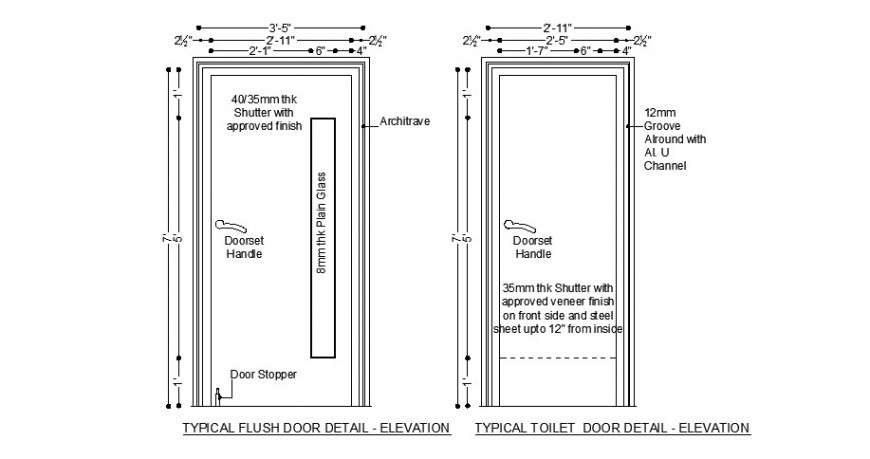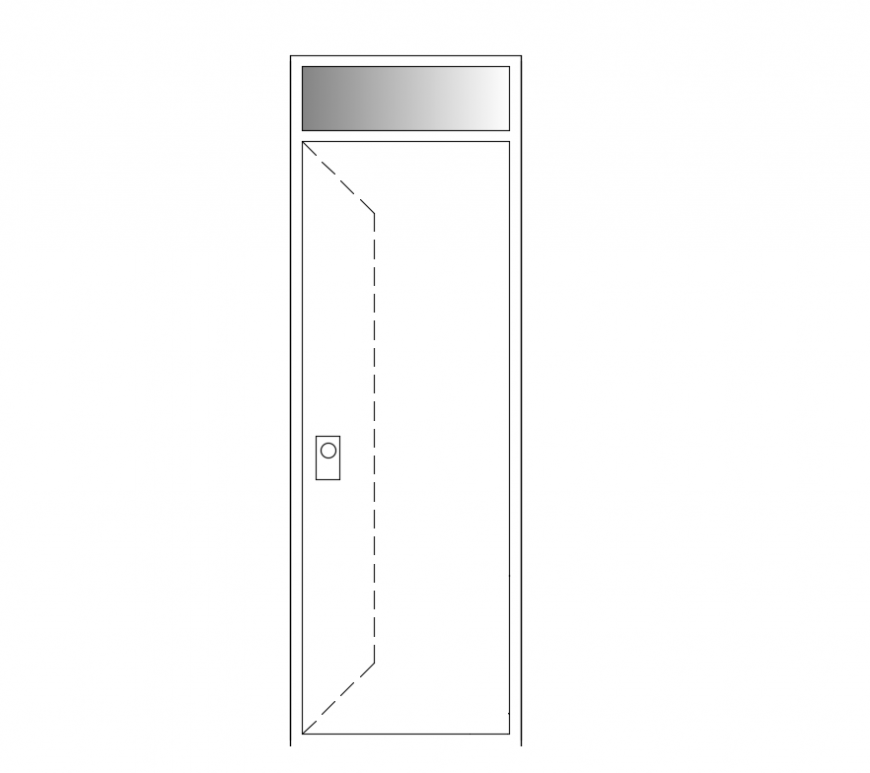Bathroom Door Cad Block Types

Bathroom door CAD blocks are essential tools for architects, designers, and contractors to create detailed and accurate drawings of bathroom spaces. They provide a wide range of options for different door styles, allowing for efficient and precise planning of bathroom layouts.
Single Doors
Single doors are the most common type of bathroom door, typically hinged on one side and swinging inwards or outwards. These doors are suitable for smaller bathrooms where space is limited.
- Standard Single Door: These doors are typically 30 inches wide and 80 inches tall, made of wood or fiberglass, and finished with paint or stain. They are commonly used in residential bathrooms and offer a simple and cost-effective solution.
- French Doors: French doors are a more elegant option, featuring two panels that swing open, creating a wider opening. They are typically made of wood or glass and can be used to create a more spacious and inviting feel in the bathroom.
Bathroom door cad block – Single doors are generally less expensive than other door types, and their simple design makes them easy to install and maintain. However, they may not provide as much privacy as double doors, and their swinging motion can take up valuable space in smaller bathrooms.
A bathroom door cad block is a digital blueprint used by architects and designers to create precise representations of bathroom doors. These blocks often include intricate details like hinges, handles, and even the door’s swing direction. However, when it comes to the unique constraints of an RV, rv bathroom door replacement can be a different beast entirely.
The compact space and limited access often necessitate creative solutions, such as sliding doors or innovative hinge systems. Once you’ve chosen your perfect RV bathroom door, you can use the cad block to integrate it seamlessly into the overall design.
Double Doors
Double doors, also known as double-leaf doors, consist of two panels that swing open, creating a wider entrance. These doors are ideal for larger bathrooms where space is not an issue and a grander aesthetic is desired.
- Double Swing Doors: These doors are typically 60 inches wide and 80 inches tall, made of wood or fiberglass, and finished with paint or stain. They are commonly used in master bathrooms and offer a luxurious and spacious feel.
- Pocket Doors: Pocket doors slide into a wall cavity, disappearing entirely when open. They are a space-saving option, especially in smaller bathrooms, as they do not require any swing space. Pocket doors are typically made of wood or fiberglass and can be finished with paint or stain.
Double doors provide more privacy and a more dramatic entrance than single doors. They can also be customized with various materials and finishes to match the overall bathroom design. However, double doors are more expensive than single doors and require more space for installation.
A bathroom door CAD block is a digital representation of a bathroom door, often used in architectural design software. It’s a powerful tool for visualizing the door’s placement and dimensions, and can even include details like hinges and handles. When designing a bathroom, a common door size is 24 x 80 inches, a standard that allows for easy access and ample privacy.
To ensure a perfect fit, you can find helpful information and guides on choosing the right 24 x 80 bathroom door at 24 x 80 bathroom door. This knowledge, combined with the precision of a CAD block, can help create a functional and aesthetically pleasing bathroom space.
Sliding Doors
Sliding doors move horizontally along a track, allowing for a space-saving solution, particularly in smaller bathrooms. They are a popular choice for modern bathrooms and can be customized with various materials and finishes.
- Bypass Sliding Doors: These doors slide past each other on a track, allowing for easy access and a sleek look. They are typically made of wood or glass and can be finished with paint or stain.
- Barn Doors: Barn doors are a popular trend in bathroom design, featuring a single panel that slides along a track on the wall. They are typically made of wood and can be customized with various finishes and hardware.
Sliding doors are a practical and stylish choice for bathrooms, offering a space-saving solution without compromising on privacy. They are also relatively easy to install and maintain. However, they may not be suitable for all bathroom layouts, and they can be more expensive than single doors.
Pocket Doors
Pocket doors slide into a wall cavity, disappearing entirely when open. They are a space-saving option, especially in smaller bathrooms, as they do not require any swing space. Pocket doors are typically made of wood or fiberglass and can be finished with paint or stain.
- Single Pocket Door: These doors are a single panel that slides into a wall cavity. They are typically 30 inches wide and 80 inches tall, made of wood or fiberglass, and finished with paint or stain.
- Double Pocket Door: These doors feature two panels that slide into a wall cavity, creating a wider opening. They are typically 60 inches wide and 80 inches tall, made of wood or fiberglass, and finished with paint or stain.
Pocket doors are a practical and space-saving option for bathrooms, offering a clean and modern aesthetic. They are also relatively easy to install and maintain. However, they can be more expensive than other door types, and they require a dedicated wall cavity for installation.
Bathroom Door Cad Block Design Considerations

Selecting the right bathroom door cad block is crucial for creating a functional and aesthetically pleasing bathroom space. It involves careful consideration of various factors, including the bathroom layout, space constraints, privacy needs, and overall design theme.
Bathroom Layout and Space Constraints, Bathroom door cad block
The bathroom layout and space constraints play a significant role in determining the suitable door cad block. For small bathrooms, a sliding door or a pocket door can save valuable space by eliminating the need for a swing arc. In contrast, larger bathrooms can accommodate traditional hinged doors with greater width and height.
Maximizing Privacy While Maintaining Openness
Designing a bathroom door that effectively balances privacy and openness is essential. A frosted glass door or a door with a privacy film can provide visual separation while allowing natural light to filter through. Alternatively, a solid door with a small window or a transom can create a sense of openness without compromising privacy.
Choosing the Right Door Style, Size, and Material
The door style, size, and material should complement the overall bathroom design. For a contemporary bathroom, a minimalist door with clean lines and a sleek finish would be suitable. A traditional bathroom might benefit from a more ornate door with intricate details. The door size should be proportionate to the bathroom size and allow for easy access. The material should be durable, moisture-resistant, and aesthetically pleasing.
Using Bathroom Door Cad Blocks in Design Projects

Bathroom door CAD blocks are essential tools for architects, interior designers, and other professionals who work on bathroom design projects. These blocks offer a quick and efficient way to add accurate and realistic representations of bathroom doors to drawings and 3D models. They save time and effort by eliminating the need to manually draw each door from scratch.
Importing Bathroom Door Cad Blocks
Importing bathroom door CAD blocks into a design project is a straightforward process. Most CAD software allows users to import blocks from various file formats, including DWG, DXF, and SKP. The exact steps may vary depending on the specific CAD software used.
- Open the CAD software: Launch the CAD software you are using for your design project.
- Navigate to the “Insert” or “Import” menu: Locate the menu option that allows you to import external files.
- Select the desired bathroom door CAD block file: Choose the specific bathroom door block file you want to import from your computer’s storage.
- Click “Open” or “Import”: This will insert the bathroom door block into your design project.
Scaling Bathroom Door Cad Blocks
Once the bathroom door CAD block is imported, it may need to be scaled to match the actual dimensions of the door you are representing. The scaling process ensures that the block accurately reflects the size of the door in your design.
- Select the bathroom door block: Click on the imported block to select it.
- Locate the “Scale” tool: Find the scaling tool in your CAD software’s toolbar or menu.
- Enter the desired scale factor: Input the scale factor that will adjust the block to the correct size. For example, if you need to scale the block by 50%, enter “0.5” in the scaling tool.
- Apply the scaling: Confirm the scaling operation to resize the bathroom door block.
Positioning Bathroom Door Cad Blocks
After importing and scaling the bathroom door block, you need to position it correctly within your design. This step ensures that the door is placed in the appropriate location within the bathroom layout.
- Move the bathroom door block: Select the block and use the appropriate movement tools in your CAD software to drag and drop it to the desired location.
- Align the block with other elements: Use alignment tools to ensure the door block is properly aligned with walls, other furniture, or other features in your design.
- Rotate the block if needed: If the door needs to be rotated to face the correct direction, use the rotation tools in your CAD software to adjust its orientation.
Creating Detailed Drawings with Bathroom Door Cad Blocks
Bathroom door CAD blocks can be used to create detailed drawings of bathrooms, including floor plans, elevations, and sections. These drawings provide a comprehensive representation of the bathroom’s layout, dimensions, and features.
- Create a floor plan: Use the bathroom door block to represent the location and orientation of the door in the bathroom floor plan.
- Add elevations and sections: Use the block to represent the door in elevations and sections, showing its height, width, and any decorative details.
- Include dimensions: Add dimensions to the drawing to indicate the size of the door and its relationship to other elements in the bathroom.
Creating 3D Models with Bathroom Door Cad Blocks
Bathroom door CAD blocks can also be used to create realistic 3D models of bathrooms. These models provide a more immersive view of the bathroom space and allow designers to visualize the design from different perspectives.
- Create a 3D model: Use the bathroom door block to represent the door in a 3D model of the bathroom.
- Add textures and materials: Apply textures and materials to the door block to create a more realistic appearance.
- Render the model: Render the 3D model to create a high-quality visual representation of the bathroom, including the door.